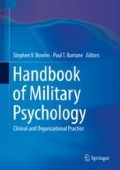Abstract
Aeromedical psychology is an integrative field that draws upon the specialty areas of clinical, operational, and industrial/organizational psychology with the intent of optimizing the selection, training, performance, safety, and well-being of aviation and aerospace personnel. Clinical issues such as individual mental and physiological well-being are considered just as important as organizational ones, including the multiple conditions that can affect the integration and performance of individuals in these systems, rules and decisions that govern everyday activities, supervision/safety/equipment issues, person–machine fit, oversight policies, and an overarching climate or culture for a particular squadron, pipeline, or military service branch. In this chapter, we discuss several ways in which aeromedical psychology research and practice contribute to military and other aviation operations, with a focus on the practical application of principles.
References
Administration of Progress Review Boards at Aviation Training Schools. (2015). NAVAVSCOLSCOM INSTRUCTION (1500.71).
Air Force Fact Sheet. (2015). MQ-9 Reaper. Retrieved from http://www.af.mil/AboutUs/FactSheets/Display/tabid/224/Article/104470/mq-9-reaper.aspx
Air Force Instruction. (2000). Aircraft, missile, nuclear, and space accident investigations (51–503). Retrieved from https://www.nrc.gov/docs/ML0303/ML030350216.pdf
Air Force Instruction. (2016). Safety investigations and reports (91–204). Retrieved from http://static.e-publishing.af.mil/production/1/af_se/publication/afi91-204/afi91-204.pdf
American Psychiatric Association. (2013). Diagnostic and statistical manual of mental disorders, fifth edition (DSM-5). Washington, DC: American Psychiatric Publishing.
Aerospace Medical Association ad hoc Working Group on Pilot Mental Health. (2012). Pilot mental health: Expert working group recommendations. Aviation, Space, and Environmental Medicine, 83, 1184–1185.
Aerospace Medical Association Pilot Mental Health Working Group Recommendations – Updated (2015). Retrieved from www.asma.org
Army Regulation. (2011). Standards of medical fitness (40–501). Retrieved from http://www.au.af.mil/au/awc/awcgate/army/r40_501.pdf
Army Regulation. (2015). Military awards (600-8-22). Retrieved from http://ec.militarytimes.com/static/pdfs/r600_8_22.pdf
Bowles, S. V. (1994). Military aeromedical psychology training. International Journal of Aviation Psychology, 4, 167–173.
Brubaker, J. D., Chartoff, R., Winkler, I., & Kaufman, P. (1983). The right stuff. Hollywood, CA United States: The Ladd Company.
Bureau of Medicine and Surgery. (2005). Manual of the Medical Department U.S. Navy. (NAVMED P-117). Retrieved from https://www.sealswcc.com/PDF/special-operations-manmed-revision-04012014-physical-exams-and-standards.pdf
Chappelle, W., McDonald, K., Prince, L., Goodman, T., Ray-Sannerud, B. N., & Thompson, W. (2014). Assessment of occupational burnout in United States Air Force Predator/Reaper “drone” operators. Military Psychology, 26, 376–385.
Chappelle, W., McDonald, K., Thompson, B., & Swearengen, J. (2012). Prevalence of High Emotional Distress of Symptoms of Post-Traumatic Stress Disorder in U.S. Air Force Active Duty Remotely Piloted Aircraft Operators 2010 USAFSAM Survey Results. Technical Report AFRL-SA-WP-TR-2013-0002. Wright-Patterson AFB, OH. Retrieved from www.dtic.mil/cgi-bin/GetTRDoc?AD=ADA577055
David, Nic, & anonymous RPA pilots & sensor operators. (2017, April 6). RPA Pilot/Sensor Perspective [Personal Interview].
Human Factors Councils and Human Factors Boards. (1997). COMNAVAIRPAC INSTRUCTION 5420.2B (5420.2). Retrieved from https://webapp1.dlib.indiana.edu/virtual_disk_library/index.cgi/3715654/FID235/Air/54202.pdf
Human Factors Councils and Human Factors Boards. (2012). CNATRA INSTRUCTION (5420.13H). Retrieved from https://www.cnatra.navy.mil/pubs/folder2/5420.13F.pdf
HIMS. (2015). Human Intervention Motives Study. Retrieved from http://www.himsprogram.com/
Hoagland, B. (2013). Manning the next unmanned air force: Developing RPA pilots of the future. Policy paper for center for 21st century security and intelligence. Foreign Policy at Brookings. Retrieved from http://dtic.mil/dtic/tr/fulltext/u2/a583381.pdf
King, R.E.(1999). Aerospace Clinical Psychology. Hants, England:Ashgate Publishing Ltd.
Olson, T., McCauley, M., & Kennedy, C. H. (2013). A history of aeromedical psychology. In C. H. Kennedy & G. G. Kay (Eds.), Aeromedical psychology. Surrey, UK: Ashgate Publishing Limited.
Otto, J., & Webber, B. (2013). Mental health diagnoses and counseling among pilots of remotely piloted Aircraft in the United States Air Force. Medical Surveillance Monthly Report, 20, 3–8.
Parsons, R. P. (1918). A search for non physical standards for naval aviators. U.S Naval Technical Bulletin, 12, 155–172.
Reason, J. (1990). Human error. New York, NY: Cambridge University Press.
Saitzyk, A. R., Alfonzo, C. A., Greydanus, T. P., Reaume, J. R., & Parsa, B. B. (2013). U.S. military standards and aeromedical waivers for psychiatric conditions and treatments. In C. H. Kennedy & G. G. Kay (Eds.), Aeromedical psychology (pp. 126–158). Surrey, UK: Ashgate Publishing Limited.
Shappell, S. A., & Wiegmann, D. A. (2000). The Human Factors Analysis and Classification System – HFACS (DOT/FAA/AM-00/7). Department of Transportation, Federal Aviation Administration, Office of Aviation Medicine, Washington, DC. Retrieved from https://www.nifc.gov/fireInfo/fireInfo_documents/humanfactors_classAnly.pdf
Strongin, T. (2015, November 15). Embedded Psychologists in the USAF [Personal interview].
Tryon, G., Lubin, A., & Creer, R. (1941). Keep ‘em flying. Ontario, CA United States: Universal Pictures.
Williams, T. J., Picano, J. J., Roland, R. R., & Banks, L. M. (2006). Introduction to operational psychology. In C. H. Kennedy & G. G. Kay (Eds.), Aeromedical psychology (pp. 193–214). Surrey, UK: Ashgate Publishing Limited.
Author information
Authors and Affiliations
Corresponding author
Editor information
Editors and Affiliations
Rights and permissions
Copyright information
© 2017 Springer International Publishing AG
About this chapter
Cite this chapter
Saitzyk, A.R., Mayfield, T.E., Sharkey, L.M., Cox Coleman, C.E. (2017). Aeromedical Psychology. In: Bowles, S., Bartone, P. (eds) Handbook of Military Psychology. Springer, Cham. https://doi.org/10.1007/978-3-319-66192-6_2
Download citation
DOI: https://doi.org/10.1007/978-3-319-66192-6_2
Published:
Publisher Name: Springer, Cham
Print ISBN: 978-3-319-66190-2
Online ISBN: 978-3-319-66192-6
eBook Packages: Behavioral Science and PsychologyBehavioral Science and Psychology (R0)

